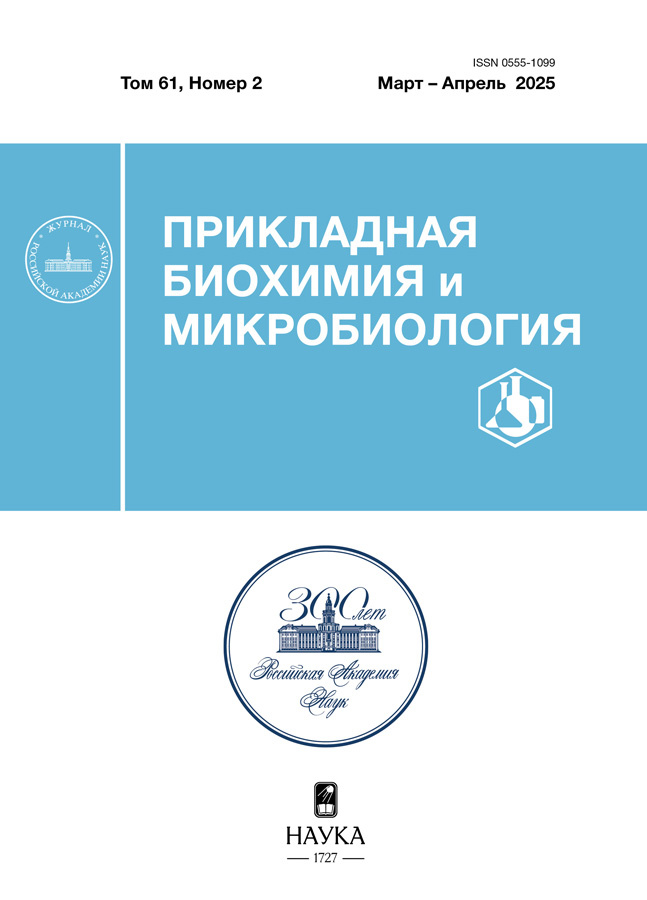Effect of the mineral composition of sulfide raw materials on bioleaching of sulfide minerals
- Авторлар: Bulaev A.G.1, Muravyov M.I.1, Melamud V.S.1, Fomchenko N.V.1
-
Мекемелер:
- Federal Research Centre “Fundamentals of Biotechnology” of the Russian Academy of Sciences
- Шығарылым: Том 61, № 2 (2025)
- Беттер: 185-193
- Бөлім: Articles
- URL: https://genescells.com/0555-1099/article/view/687475
- DOI: https://doi.org/10.31857/S0555109925020087
- EDN: https://elibrary.ru/EOQXGV
- ID: 687475
Дәйексөз келтіру
Аннотация
Bioleaching of nickel-copper sulfide ore, 2 sulfide copper-nickel concentrates, and copper-zinc concentrate was studied. It was shown that specific rates of nickel leaching were similar in experiments with all studied raw materials. It was 59.3, 58.7, and 54.4 mg/(g·d) in the case of the ore, concentrate 1, and concentrate 2, respectively. Specific rate of zinc leaching from copper-zinc concentrate was 248.6 mg/(g·d). Copper extraction level reached 98.5%, while its content decreased from 7.4% (in the concentrate) to 0.21% (leaching residue). Specific copper leaching rate (7.3–14.8 mg/(g·d)) was lower than those of nickel and zinc. In contrast to nickel and zinc, copper content in bioleaching residue increased in comparison to the concentrate: in the case of copper-nickel concentrates it increased from 15.1 to 17.8% (concentrate 1) and from 19.1 to 19.7% (concentrate 2), while in the case of copper-zinc concentrate, it increased from 10.1 to 16.1%. Thus, bioleaching of all studied concentrates made it possible to obtain copper concentrates with comparatively high copper content (16–19%), which can be commercial products for pyrometallurgy. A comparative analysis of the leaching processes of the selected raw materials will allow to assess the prospects of using the approach under study for processing concentrates and ores of various compositions and with different ratios of non-ferrous metal minerals.
Негізгі сөздер
Толық мәтін
Авторлар туралы
A. Bulaev
Federal Research Centre “Fundamentals of Biotechnology” of the Russian Academy of Sciences
Хат алмасуға жауапты Автор.
Email: bulaev.inmi@yandex.ru
Winogradsky Institute of Microbiology
Ресей, Moscow, 119071M. Muravyov
Federal Research Centre “Fundamentals of Biotechnology” of the Russian Academy of Sciences
Email: bulaev.inmi@yandex.ru
Winogradsky Institute of Microbiology
Ресей, Moscow, 119071V. Melamud
Federal Research Centre “Fundamentals of Biotechnology” of the Russian Academy of Sciences
Email: bulaev.inmi@yandex.ru
Winogradsky Institute of Microbiology
Ресей, Moscow, 119071N. Fomchenko
Federal Research Centre “Fundamentals of Biotechnology” of the Russian Academy of Sciences
Email: bulaev.inmi@yandex.ru
Winogradsky Institute of Microbiology
Ресей, Moscow, 119071Әдебиет тізімі
- Brierley C., Brierley J. // Appl. Microbiol. Biotechnol. 2013. V. 97. № 17. P. 7543–7552. https://doi.org/10.1007/s00253-013-5095-3
- Batty J., Rorke G. // Hydrometallurgy. 2006. V. 83. № 1–4. P. 83–89. https://doi.org/10.1016/j.hydromet.2006.03.049
- Gentina J.C., Acevedo F. // Minerals. 2016. V. 6. № 1. 23. https://doi.org/10.3390/min6010023
- Johnson D. // Minerals. 2018. V. 8. № 8. 343. https://doi.org/10.3390/min8080343
- Fomchenko N., Muravyov M. // Minerals. 2020. V. 10. № 12. 1097. https://doi.org/10.3390/min10121097
- Kaksonen A.H., Lakaniemi A.-M., Tuovinen O.H. // J. Cleaner Prod. 2020. V. 264. 121586. https://doi.org/10.1016/j.jclepro.2020.121586
- Kaksonen A.H., Mudunuru B.M., Hackl R. // Hydrometallurgy. 2014. V. 142. P. 70–83. https://doi.org/10.1016/j.hydromet.2013.11.008
- Mahmoud A., Ceza P., Hoadley A.F.A., Contamin F., D’Hugues P. // Int. Biodeterior. Biodegrad. 2017. V. 119. P. 118–146. https://doi.org/10.1016/j.ibiod.2016.09.015
- Fomchenko N., Muravyov M. // Hydrometallurgy. 2019. V. 185. P. 82–87. https://doi.org/10.1016/j.hydromet.2019.02.002
- Esmailbagi M.R., Schaffie M., Kamyabi A., Ranjbar M. // Hydrometallurgy. 2018. V. 180. P. 139–143. https://doi.org/10.1016/j.hydromet.2018.07.020
- Fomchenko N., Muravyov M. // Appl. Biochem. Microbiol. 2017. V. 53. № 6. P. 715–718. https://doi.org/10.1134/S0003683817060059
- Fomchenko N., Uvarova T., Muravyov M. // Miner. Eng. 2019. V. 138. P. 1–6. https://doi.org/10.1016/j.mineng.2019.04.026
- Watling H.R. // Hydrometallurgy. 2008. V. 91. № 1–4. P. 70–88. https://doi.org/10.1016/j.hydromet.2007.11.012
- Sun J.Z., Wen J.K., Wu B., Chen B.W. // Minerals. 2020. V. 10. № 3. 289. https://doi.org/10.3390/min10030289
- Muravyov M.I., Fomchenko N.V. // Appl. Biochem. Microbiol. 2019. V. 55. № 4. P. 414–419. https://doi.org/10.1134/S0003683819040124
- Muravyov M., Panyushkina A., Bulaev A., Fomchenko N. // Minerals Engineering. 2021. V. 170. 107040. https://doi.org/10.1016/j.mineng.2021.107040
- Muravyov M., Panyushkina A., Fomchenko N. // Journal of Environmental Management. 2022. V. 318. 115587. https://doi.org/10.1016/j.jenvman.2022.115587
- Muravyov M., Panyushkina A. // Hydrometallurgy. 2023. V. 219. 106067. https://doi.org/10.1016/j.hydromet.2023.106067
- Muravyov M., Panyushkina A., Fomchenko N. // Minerals Engineering. 2022. V. 182. 107586. https://doi.org/10.1016/j.mineng.2022.107586
- Муравьёв М.И., Панюшкина А.Е., Меламуд В.С., Булаев А.Г., Фомченко Н.В. // Прикл. биохимия и микробиология. 2021. Т. 57. № 4. С. 380–387. https://doi.org/10.31857/S0555109921040115
- Фомченко Н.В., Панюшкина А.Е., Меламуд В.С., Муравьёв М.И. // Прикл. биохимия и микробиология. 2022. Т. 58. № 4. С. 382–387. https://doi.org/10.31857/S0555109922040043
- Fu K., Ning Y., Chen S., Wang Z. // Mineral Processing and Extractive Metallurgy (Trans. Inst. Min. Metall. C). 2016. V. 125. № 1. P. 1–4. https://doi.org/10.1179/1743285515Y.0000000013
- Zhao H., Wang J., Yang C., Hu M., Gan X., Tao L. et al. // Hydrometallurgy. 2015. V. 151. P. 141–150. https://doi.org/10.1016/j.hydromet.2014.11.009
- Kondrat’eva T.F., Pivovarova T.A., Tsaplina I.A., Fomchenko N.V., Zhuravleva A.E., Murav’ev M.I. et al. // Microbiol. 2012. V. 81. № 1. V. 1–24. https://doi.org/10.1134/S0026261712010080
- Panyushkina A.E., Tsaplina I.A., Kondrat’eva T.F., Belyi A.V., Bulaev A.G. // Microbiol. 2018. V. 87. № 3. P. 326–338. https://doi.org/10.1134/S0026261718030086
- Watling H.R., Collinson D.M., Fjastad S., Kaksonen A.H., Li J., Morris C., Perrot F.A., Rea S.M., Shiers D.W. // Miner. Eng. 2014. V. 58. P. 90–99. https://doi.org/10.1016/j.mineng.2014.01.022
- Mason L.J., Rice N.M. // Miner. Eng. 2002. V. 15. № 11. P. 795–808. https://doi.org/10.1016/S0892-6875(02)00118-8
- Sun J., Wen J., Wu B., Chen B. // Minerals. 2020. V. 10. № 3. 289. https://doi.org/10.3390/min10030289
- Watling H.R. // Hydrometallurgy. 2006. V. 84. № 1–2. P. 81–108. https://doi.org/10.1016/j.hydromet.2006.05.001
- Hedrich S., Joulian C., Graupner T., Schippers A., Guezennec A.G. // Hydrometallurgy. 2018. V. 179. P. 125–131. https://doi.org/10.1016/j.hydromet.2018.05.018
- Silverman M.P., Lundgren D.G. // J. Bacteriol. 1959. V. 77. № 5. P. 642–647. https://doi.org/10.1128/jb.77.5.642-647.1959
- Davis D.G., Jacobsen W.R. // Anal. Chem. 1960. V. 32. № 2. P. 215–217. https://doi.org/10.1021/ac60158a024
- Souza A.D., Pina P.S., Leao V.A., Silva C.A., Siqueira P.F. // Hydrometallurgy. 2007. V. 89. № 1–2. P. 72–81. https://doi.org/10.1016/j.hydromet.2007.05.008
- Wang Y., Chen X., Zhou H. // Biores. Technol. 2018. V. 265. P. 581–585. https://doi.org/10.1016/j.biortech.2018.07.017
- Riekkola-Vanhanen M., Heimala S. // Proceedings of an International Biohydrometallurgy Symposium. 1993. V. 1. P. 561–570.
Қосымша файлдар















